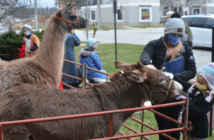Jessica L. Anschutz of the Lewis Center staff reports on an intergenerational ministry that teaches children about the significance of Holy Week and Easter. She shares insights for how congregations might launch a similar effort to educate children and reach new people.
“Thanking God It’s Good Friday” (TGIGF) is a ministry developed by Jesse Lee Memorial United Methodist Church and expanded over the years by Rev. Maria-Pia Seirup. TGIGF brings to life Melody Carlson’s children’s book, Benjamin’s Box: The Story of the Resurrection Eggs. The book tells the Easter story through the eyes of a child, Benjamin, who learns about Jesus by following him around Jerusalem. The Good Friday activities begin with K-3 children gathering in small groups inside a large hall for songs and an introduction to Benjamin’s Box. From there, the groups of 10 to 12 children are led by shepherds (two adults and one youth) on a journey through six story centers and four to six craft/activity stations, spending about 14 minutes at each one.
When the children arrive, they receive a name tag color-coded for their small group, a treasure chest or story box that they will decorate, and a bag to hold their crafts and story box. At each story center they receive a symbol, such as a piece of hay, a bit of donkey fur, a coin, a piece of linen, which they add to their story box.
Reinforcing the theme and the story
Everything about TGIGF is focused on Holy Week and Easter: the music, the storytelling, the crafts, and the snacks called “resurrection biscuits.” Each story center is appropriately decorated and hosted by costumed storytellers. (This is a great use for costumes from the church’s annual Christmas pageant.) Setting up the story centers is an opportunity to be creative. At Jesse Lee Memorial, the Garden of Gethsemane story center is outside in the church’s memorial garden, weather permitting. When it is cold outside, a classroom is filled with plants to simulate a garden. A round table is covered to look like a large rock and is rolled away from a classroom (or gazebo) enclosed as the empty tomb.
Meeting the community’s needs
When school is closed on Good Friday, TGIGF gives children a chance to learn about the significance of Holy Week and Easter while providing childcare for working parents. In the early years of the ministry, most parents happily dropped their children off for the half-day event held from 8:45 a.m. to 12:30 p.m. Over the years, more parents have chosen to become volunteers. Other parents stay to take the journey with their children, so TGIGF was adapted for families to journey together through the centers. If your community has a lot of young families, consider offering a nursery for infants and toddlers so that their parents can volunteer. Jesse Lee Memorial provides a nursery for children of volunteers.
Meeting children where they are
TGIGF initially was designed for children in kindergarten through fifth grade. Over time, the older children had learned all the stories and had completed all the activities. Recognizing that the fourth and fifth graders no longer found the story centers engaging, a special program was developed for them. Now, fourth and fifth graders eat popcorn and resurrection biscuits while they watch The Chronicles of Narnia: The Lion, the Witch and the Wardrobe, a movie based on a novel by C.S. Lewis. Then they discuss the film with adults equipped to talk with them about the theme of resurrection — often the pastor. The fourth and fifth graders have the option to join the craft/activity stations during the film’s intermission.
Many of the families participating in TGIGF have preschoolers, so a separate preschool program is offered with a more age-appropriate curriculum. Rather than move little ones through the stations, the preschoolers are dropped off in a classroom where they hear about Holy Week and Easter and then move to a tent for arts and crafts. At Jesse Lee Memorial, the preschool program is limited to children from the congregation and the church’s preschool.
Any parent dropping off children must first complete a registration form with at least two emergency contacts and a permission slip for each child. All aspects of TGIGF align with the congregation’s Safe Sanctuary (or similar) policy and all relevant protocols such as mask wearing, social distancing, and good ventilation have been observed during the pandemic.
Engaging volunteers of all ages
The number of volunteers depends on the size of the church’s program. The number also includes substitutes in case a volunteer is sick or unable to participate. For larger programs, a director and an assistant director are trained for each of the three groups: preschoolers, kindergartners through third graders, and fourth and fifth graders.
Volunteers are empowered to be creative in decorating the story centers and developing the plans for each program. Adults of all ages serve as storytellers and shepherds. To prepare for their important roles, storytellers at Jesse Lee Memorial participate in a training event or receive one-on-one instruction. They tell the stories, but they are also prepared to adapt the story based on the age of the children and to answer the children’s questions. For smaller programs, storytellers may move from story center to story center, minimizing the number of storytellers needed.Energetic middle schoolers deliver snacks to the various rooms and serve as runners.In addition to serving as shepherds, youth make resurrection biscuits and lead crafts for the preschoolers.
Starting small
Congregations planning to offer TGIGF should consider the ages of the children in the congregation and the community. Rather than begin with specialized programs for each age group, it may be wise to start with a program suited to one group that could grow, expand, and adapt over the years based on the needs of the church context and the availability of volunteers. At Jesse Lee Memorial, TGIGF has grown to include 120 children. In planning the space needed, small groups or families can move to different stations set up in a larger room instead of moving from room to room. As the program grows, keep in mind that timing is key. Everyone has to be in sync as they move from station to station.
Becoming witnesses
Volunteers are not only equipped to share the story of Holy Week with the TGIGF children but also to become witnesses both within and beyond the church. At the end of the program, before they close with a song, the kindergartners through third graders gather to review the story using the symbols from their story boxes. Then, the children are encouraged to use their story box treasures to share the story with their friends and family.
Build relationships
TGIGF is a great way to make connections with children and their families in your community and to build relationships within the congregation as volunteers of all ages work together to tell the story of Holy Week and Easter. Small membership congregations can collaborate with nearby congregations, drawing together participants and volunteers from across the congregations. Those who participate in TGIGF can be invited to join you for worship on Easter Sunday, for the annual Easter egg hunt, and to engage in other ministries.
Related Resources
- “What is Messy Church?”, a Leading Ideas Talks podcast episode featuring Johannah Myers
- How to Organize an Intergenerational Morning of Service for MLK Day by Jessica L. Anschutz
- Why Intergenerational Ministry? by Liz Perraud







